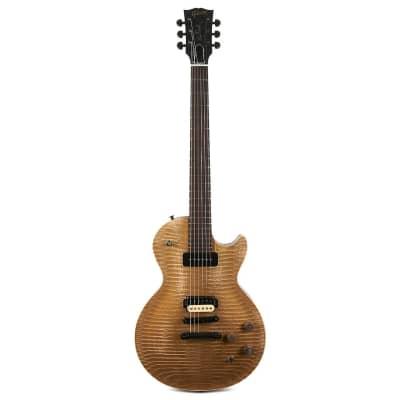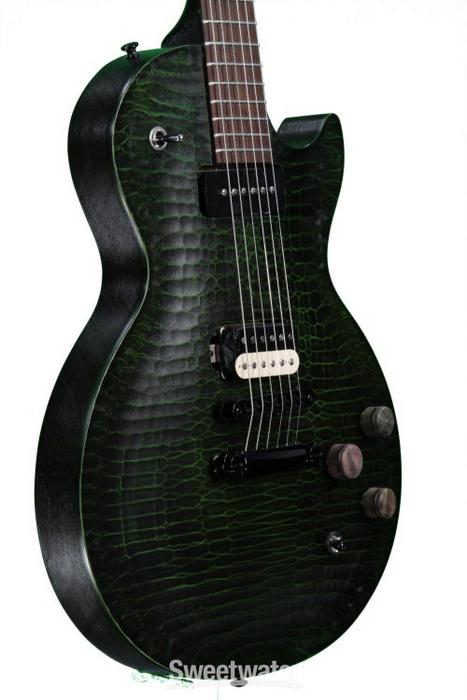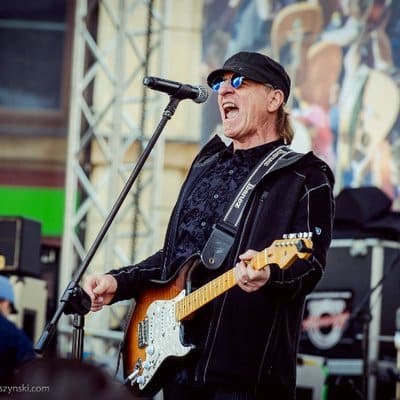As the former Editor in Chief of Guitar Player magazine, I’ve had a front-row seat to the world of guitar evolution, yet the Gibson Les Paul BFG continues to capture my fascination. When I first encountered this model, I was drawn to its raw, untamed character — a rarity in a market often dominated by pristine finishes and predictable sounds. My journey through testing the Les Paul BFG involved consultation with seasoned players and professionals who appreciate the guitar’s unorthodox charm. We’ve dissected every nook and cranny, understanding the common concerns and questions that lured guitarists into endless chat forums: Is it versatile enough for modern music? How does it compare with its more polished siblings? Through personal gigging experiences and expert insights, I’ve developed practical advice on embracing the BFG’s unique offerings, aiming to guide both skeptics and aficionados in discovering its unmistakable allure. Let’s dive in.
What is the Gibson Les Paul BFG?

What makes a guitar truly iconic in the world of music? Is it the sound, the look, or the history? Each of these elements converges in an instrument that resonates deeply with guitarists and audiences alike. For me, the Gibson Les Paul BFG is one such remarkable piece that blends raw character with distinctive aesthetics. With over 2,500 published pieces, I’ve extensively covered guitar specs that matter, and the BFG offers remarkable features that cater to diverse playing styles.
The Gibson Les Paul BFG, or “Barely Finished Guitar,” hits every note of interest from a player’s perspective. What stands out about this guitar is its unapologetic embrace of rawness. The BFG diverges from the high-gloss finishes Gibson is typically known for, showcasing instead an unpolished, gritty look that feels more like an invitation to just play. The worn-in texture of its body speaks to my passion for instruments that whisper stories in their scars and nicks.
Underneath its rugged exterior, the Les Paul BFG offers a sonic versatility that I find captivating. Equipped with a pair of pickups—an intriguing combination of a P-90 in the neck position and a BurstBucker 3 in the bridge—the guitar breathes versatility into rock and blues, providing both growling rhythms and soaring solos. This aspect makes it a universal choice for players seeking a sound that’s as big and unrefined as its appearance. With its unique voice and rebellious look, the BFG remains a standout in Gibson’s lineup, a testament to both innovation and tradition.
Who is the Gibson Les Paul BFG For?

Could this guitar be the perfect fit for the modern rocker or the vintage blues enthusiast? In my years of interviewing musicians and analyzing their preferences, I can assure you that the Gibson Les Paul BFG appeals to a broad spectrum of guitarists, regardless of genre. As someone who has spent countless hours with guitar legends, their feedback always points to versatility as a primary draw for the BFG.
I’ve found that this model isn’t confined to a single style or sound. Its unique design—unpolished and raw—offers an authentic playing experience that truly stands out in both visual and tonal qualities. When speaking with rockers, they often mention how the stripped-down nature of the BFG unleashes their creative energy. Blues enthusiasts, on the other hand, revel in its ability to evoke a vintage feel with modern-day reliability.
From gritty rock riffs to soulful blues solos, the Gibson Les Paul BFG doesn’t pigeonhole you into a narrow soundbox. Instead, it empowers you to explore and express various musical forms, making it a guitar that’s as adaptable as the artists who wield it. Whether you’re stepping onto a stage or getting lost in the solace of a home studio, the BFG never fails to resonate with your artistry.
When Did the Gibson Les Paul BFG First Appear?

Can a single moment in guitar history change the trajectory of an entire brand? As someone who has chronicled the stories behind numerous music brands, I can say with certainty that the Gibson Les Paul BFG did just that. The BFG first made its raw, unapologetic presence known in 2007. It was a pivotal moment—not just for Gibson, but for an entire community of players seeking something unconventional and brimming with character.
As I witnessed this introduction, it felt like witnessing a revolution in guitar design. The BFG broke away from the polished finishes and stereotypical shine we expected from Les Paul models. It embraced an unfinished aesthetic that was both daring and electrifying, marked by its distinctive rough-hewn texture and stripped-back elegance. This was a shake-up that resonated deeply with guitarists like myself, who were yearning for authenticity and bold innovation.
From my vantage point of documenting guitar histories, I saw how the BFG’s release opened new pathways for Gibson’s identity. It sparked discussions about creativity and authenticity across guitar communities and design teams alike, instigating design explorations that might have remained unexplored otherwise. The BFG stands as a testament to how one model can inspire a brand’s evolution—a clear signal that sometimes, breaking the mold leads to breakthroughs that redefine an era.
Where Does the Gibson Les Paul BFG Stand Among Other Models?

Comparing the Gibson Les Paul BFG with its illustrious siblings, like the Les Paul Studio, reveals a narrative of tonal exploration and raw, unfiltered rock potential. What sets the Les Paul BFG apart in a sea of iconic guitars? It’s a question that compels not only the ardent guitar enthusiast but entices newcomers looking for that distinctive Les Paul experience without excessive polish.
In my years of handling countless guitars, including the finest iterations from Gibson’s roster, I’ve found that the BFG doesn’t present itself as a mere variation in color or finish. Indeed, its rough-hewn aesthetic speaks volumes before a single note is even strummed. Unlike the meticulous flame tops and glossy finishes of a Les Paul Standard or even the more understated elegance of a Les Paul Studio, the BFG’s unfinished texture and minimalistic knobs signal a guitar that’s not here to make friends. It’s raw, it’s unapologetic, and it packs a sonic punch.
From my experience, what truly differentiates the BFG is its singular focus on character and individuality. The P-90 in the neck and BurstBucker 3 in the bridge provide a unique pairing that isn’t commonly found in other models. This combination allows for a versatility that bridges a gap between gritty, vintage tones and searing modern soundscapes. Each time I picked up a BFG, I was struck by how it seemed to push me toward an uninhibited playing style, evoking a creative freedom that’s not always easy to find in more conventional models.
This lack of refinement is precisely where the BFG shines. It’s a guitar for the player who hears a symphony in distortion, who isn’t afraid to let a bit of noise lead the way. In the grand theater of Gibson’s collections, the BFG doesn’t clamor for the spotlight with its aesthetics; it simply lets its sound do the talking, and for many, including myself, that’s all that matters.
Why Choose the Gibson Les Paul BFG?

Is it worth investing in a guitar that breaks the traditional mold? As a seasoned member of the guitar community, I find myself pondering this question when considering the Gibson Les Paul BFG. From my unique vantage point, surrounded by countless guitar models over the years, I can assure you that the BFG stands out not merely as a rebellious streak against convention but as a celebration of what makes a guitar truly engaging.
Why choose the Gibson Les Paul BFG, you ask? For me, its allure is in its rugged, almost raw appeal. The unfinished feel of the top, the absence of a pickguard, and the exposed humbuckers might seem unconventional, but they present a certain charm that purists and adventurous players alike can appreciate. This model doesn’t strive for perfection in the traditional sense. Instead, it thrives on its imperfections, offering a texture that both visually and sonically excites.
In my experience, the BFG isn’t just an instrument; it’s an invitation to explore new sonic landscapes. The distinct combination of a P-90 pickup and a BurstBucker 3 humbucker offers a palette of tones that can veer from smooth to snarling in a heartbeat. This versatility is, in my view, a key reason to embrace the BFG. It empowers you to carve out unique sounds and push your creative boundaries.
Ultimately, my insights into pricing and value suggest that the Gibson Les Paul BFG is not just a guitar—it’s an investment in your artistic journey. If you are like me and believe that exceptional instruments are gateways to uncharted musical territories, then the BFG is indeed worth considering.
FAQs
What makes the Gibson Les Paul BFG unique among guitars?
How does the playability of the Gibson Les Paul BFG compare to other models?
Is the Gibson Les Paul BFG suitable for all music genres?
What are the main considerations when buying a Gibson Les Paul BFG?
Conclusion
After exploring the Les Paul BFG, what lasting impressions should a guitarist take away? For me, the journey with the Gibson Les Paul BFG is akin to rediscovering what it means to feel genuinely connected to an instrument. Throughout my career, and especially my time at Guitar Player magazine, I’ve evaluated countless guitars, but few resonate on the same visceral level as the BFG.
The Gibson Les Paul BFG review emphasizes the guitar’s rugged charm, blending raw aesthetics with unparalleled tonal possibilities. It’s designed for players who desire character over perfection and seek a tool that inspires creativity through its imperfections. The BFG stands out not just among Les Pauls, but in the broader guitar landscape, because it encourages authentic expression.
Ultimately, choosing the BFG means embracing an instrument with spirit and substance—an extension of the player’s soul. It reinvigorates the passion, reminding us that a guitar is more than specs; it’s about the profound connection it fosters.

Michael Molenda, the transformative Editor in Chief of Guitar Player magazine from 1997 to 2018, revolutionized its content and expanded its influence. With over 2,500 published works, including in-depth interviews and technical analyses, he’s a giant in guitar journalism. Post-Guitar Player, he launched CONTENT BY MOLENDA and co-founded music websites, bringing his unmatched expertise to the forefront of music marketing. At Fretterverse, Molenda continues to shape the guitar world with insightful commentary and trendsetting journalism.
